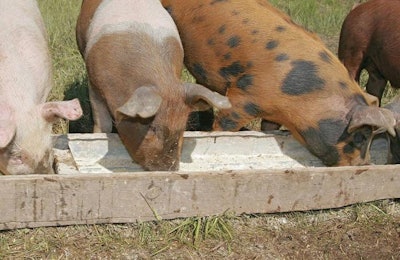
Soybean meal (SBM) is a common protein source that supplies the majority of protein in most animal diets. The attractive amino acid profile, economical cost and availability contribute its use as a protein source.
However, there are negative nutritional factors that can limit SBM inclusion in young animal diets. The presence of anti-nutritional factors such as raffinose, stachyose and trypsin inhibitor (TI) prohibit the use of higher levels of SBM in young animal diets.
Benefits of solid-state fermentation versus submerged fermentation
Research by Soares et al. compared solid-state fermentation (SSF) with submerged fermentation (SF) and protease production of Bacillus subtilis. They found that the enzyme concentration was 10-fold greater and enzyme productivity was 45 percent higher than the protease produced from SF (Soares VF, 2005). This indicates that SSF produces more robust proteases in higher quantities when compared to SF.
Physical transformation through solid-state fermentation
Aspergillus spp. has been utilized in Asian cultures for many years to transform soybean or grain products into flavor enhanced foods, alcoholic beverages or even act as natural preservatives. Aspergillus spp. produce filamentous roots called hyphae, which grow into the substrate. Enzymes are secreted into the substrate during hyphae growth, which help transform the native product. Recently it was discovered that solid-state fermentation of soybean meal with Aspergillus oryzae could enhance the nutrient properties and decrease anti-nutritional factors, making it a suitable protein source for young animal diets.
Use of dual microbes for solid-state fermentation
Although it appears that Aspergillus oryzae can be the workhorse for soybean meal transformation through its production of endo-proteases and other enzymes, it can have its limitations. The use of Bacillus subtilis can synergistically improve the nutrient quality of SSF soybean meal as it produces extracellular proteases.

Hyphae structures create paths for Bacillus subtilis to penetrate the substrate.
During the fermentation of soybean meal, the Aspergillus oryzae produce hyphae, which grow into the soybean meal. Figure 1 illustrates how these hyphae structures create paths for Bacillus subtilis to penetrate the substrate. As this penetration occurs the fungi and bacterium continue to produce enzymes, such as protease, amylase, and other enzymes. These enzymes continue to degrade the soybean meal as they travel further into the substrate. This enhanced degradation technique allows the proteases and amylases and other enzymes to break down proteins, starches and other important nutrients from within the soy rather than only on the surface. Figure 2 shows the Aspergillus oryzae growing into the soybean meal particles and the degradation of the materials. Figure 3 shows the soybean meal particle at various stages of the fermentation process.

The hyphae of Aspergillus oryzae grows into the soybean meal particle, increasing surface area and creating channels for enzymatic degradation.

Illustrated here is the degradation of the soybean meal particle by the microbes at various stages of the fermentation process.
Reduction of anti-nutritional factors in soybean meal
A majority of trypsin inhibitors found in SBM resides at 21.5 kDa (Hwang, 1977); hydrolysis of proteins within this molecular weight range could potentially decrease TI content.
Recent fermentation technology has shown the benefit of reducing TI to levels that are nearly undetectable by laboratory analysis. This is completed by proteases produced by the Aspergillus spp. during the fermentation process.
A study by Hong et al. evaluated the effects of food-grade soybean and feed-grade soybean meal fermentation with Aspergillus oryzae. They found that fermentation significantly eliminated (P<0.05) most of the TI from both soybeans and soybean meal (Hong, 2004). In Figure 4, a sodium dodecyl sulphate-polyacrylamide gel electrophoresis (SDS PAGE) illustrates protein transformation of SBM fermented with Aspergillus oryzae. Note the absence of bands at 21.5 kDa. This indicates that TI has been significantly reduced or eliminated. They also observed a significant decrease in protein molecular weight (P<0.05) when compared to soybean meal. Another study by GAO et al. showed an 89.2 percent decrease in TI for soybean meal fermented with when compared to conventional SBM (You-ling GAO, 2013).

Protein hydrolysis through solid-state fermentation with Aspergillus oryzae significantly increases the amount of low-molecular weight proteins when compared to conventional soybean meal. (Soybean meal fermented with Aspergillus oryzae, left. Conventional soybean meal, right.)
Raffinose and stachyose
Research has shown that Aspergillus spp. can also produce α-galactosidases, effectively reducing raffinose and stachyose content. Research by Cruz et al. have shown that fungal α-galactosidases can successfully remove raffinose and stachyose from soya whey and soya milk (Cruz R. B., 1981) (Cruz, 1982). Research by Mansour and Khalil have shown a significant reduction in raffinose and stachyose in Chickpea flour when treated with fungal α-galactosidases from Aspergillus spp. (P<0.05) (Mansour, 1998).
References available from author upon request.

















